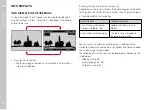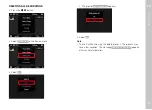
EN
Picture mode
97
Notes
• The following applies for set compensation values, no matter
how they were initially set: They remain effective until they are
manually reset to
0
0
, i.e. even if the camera is switched off and
on again in the meantime.
•
Flash Exposure Compensation
Flash Exposure Compensation
is not available if flash units with an
integrated compensation function are used, e.g. Leica SF 58.
• A compensation value configured on the camera will be
overruled when a relevantly equipped flash unit is attached, e.g.
a Leica SF 60 and a compensation value is entered on that flash
unit.
• The menu item
Flash Exposure Compensation
Flash Exposure Compensation
can only be used in
conjunction with flash units on which the correction value
cannot be set manually (e.g. Leica SF 26).
• A brighter flash illumination with Plus compensation will require
a greater flash intensity. Flash exposure compensation will
therefore impact on the flash range: A Plus correction will
decrease it, a Minus correction will increase it.
• An exposure compensation set on the camera will only affect
the measurement of ambient light. If a simultaneous TTL flash
exposure metering compensation is desired in flash mode, then
it must be additionally set on the flash unit. (Exception: On the
Leica SF 26, the compensation value must be set on the camera
via menu control.)
FLASH PHOTOGRAPHY
▸
Switch on the flash unit
▸
Set the desired guide number control mode (e.g. TTL or GNC =
Guide Number Control) on the flash unit
▸
Switching the camera on
▸
Set the desired exposure mode, shutter speed and/or aperture
setting
• It is imperative to take note of the shortest flash sync speed,
as it determines whether a "normal" flash or an HSS flash is
fired.
▸
Tap the shutter button before each flash exposure to activate
exposure metering
• The flash unit may not fire if this step is missed by pressing
the shutter button down completely and skipping these
settings.
Notes
• A flash unit that is not ready to flash may cause incorrect
exposures or error messages in the camera.
• Studio flash systems may have a very long flash firing duration. It
may therefore be advantageous to select a slower shutter speed
than 1⁄180 s when using such a system. The same applies for
RF-controlled flash firing for so-called "off-camera" flashes, as
the transmission time may cause a delay.
• Serial exposures and automatic bracketing with flash are not
available.
• Use a tripod to prevent blurring at slow shutter speeds.
Alternatively, you can select a higher sensitivity.
Summary of Contents for 20 002
Page 1: ...LEICA M10 R Instruction manual ...
Page 11: ...EN 11 Safety remarks ...
Page 23: ...EN Part Designations 23 ...
Page 41: ...EN Preparation 41 ...
Page 61: ...EN Camera basic settings 61 ...
Page 99: ...EN Picture mode 99 ...
Page 131: ...EN FAQ 131 ...
Page 141: ...EN Index 141 ...















































